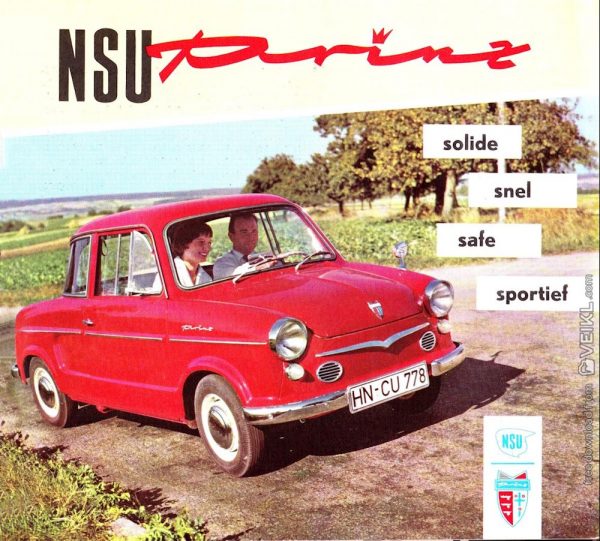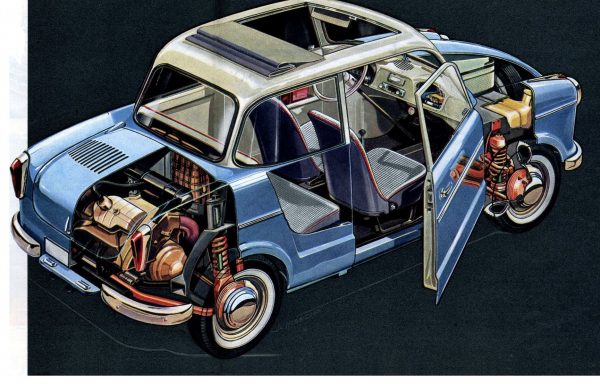NSU Prinz I
The Beginning of a Legacy
The NSU Prinz I, introduced in 1957, marked the beginning of NSU’s foray into the compact car market. This small, economical car set the stage for future models, showcasing NSU’s innovative approach to automotive engineering. With its lightweight design and efficient engine, the Prinz I quickly became a favorite among drivers looking for an affordable and reliable vehicle.
Presented in 1957, the NSU Prinz I was the first post-war NSU car, presented at the Frankfurt motor show with the German slogan “Fahre Prinz und Du bist König” – “Drive a Prince and you’re a king”, in English. A first pilot preproduction of 150 cars was successful, followed by an official launch in March 1958.
The NSU Prinz I was the first model in the Prinz series, introduced in 1958. As NSU’s entry into the compact car market, the Prinz I marked the brand’s shift from motorcycle production to small automobiles. With its innovative engineering, including a rear-mounted air-cooled engine, the Prinz I set the foundation for a series that would grow to include higher-performance models and establish NSU as a respected manufacturer in the compact car segment.
Historical Background
Launched at the 1957 Frankfurt Motor Show and officially available in 1958, the NSU Prinz I was developed to meet the growing demand for affordable, fuel-efficient cars in postwar Europe. NSU was well-known as a motorcycle manufacturer but recognized the market potential for small, economical cars, leading to the creation of the Prinz. Its compact dimensions, lightweight build, and efficient engine made it well-suited for city driving, and it quickly became popular in Germany and other parts of Europe.
The success of the Prinz I laid the groundwork for future models in the Prinz series, which would later include sportier and more powerful versions such as the Prinz 4, Prinz 1000, and Prinz TT.
Technical Specifications
The NSU Prinz I was designed to be simple yet efficient, with specifications that emphasized economy and practicality. Below are the key technical details:
- Displacement: 583 cc
- Compression Ratio: Approximately 7.5:1
- HP Output: 20 hp at 5,000 rpm
- Torque Output: Around 3.9 kg/m at 3,000 rpm
- Transmission: 4-speed manual
- Length: 3,130 mm
- Width: 1,380 mm
- Height: 1,360 mm
- Weight: 510 kg
- Wheelbase: 2,020 mm
- 0-100 km/h: Approximately 33 seconds
- Top Speed: 105 km/h
Design and Mechanical Features
The Prinz I was built with efficiency in mind, combining a compact and simple design with an innovative air-cooled engine. This made it highly practical and economical, ideal for the European market’s need for affordable transportation.
- Rear-Mounted Engine:
- The Prinz I featured an air-cooled inline-twin engine positioned at the rear, which helped to simplify the design and improve weight distribution. This engine layout was ideal for city driving, as it provided adequate power while keeping fuel consumption low.
- The 583 cc engine was compact and required minimal maintenance, fitting well within NSU’s philosophy of producing economical vehicles.
- Simple Suspension:
- Front Suspension: The front suspension consisted of coil springs with telescopic dampers, providing a comfortable ride for a car of its size and purpose.
- Rear Suspension: The rear swing-axle suspension helped to manage the car’s rear-heavy weight distribution, though it could be prone to oversteer under extreme conditions.
- Lightweight Construction:
- The Prinz I was designed with a focus on weight reduction, featuring a compact body structure that kept its weight down to just 510 kg. This lightweight construction contributed to the car’s fuel efficiency and ease of handling.
- Braking System:
- Equipped with drum brakes on both the front and rear wheels, the Prinz I’s braking system was basic but sufficient for the car’s low weight and modest power output.
- Body and Interior Design:
- The Prinz I featured a minimalist design with rounded lines and a compact, boxy shape that maximized interior space. Its small dimensions made it ideal for navigating narrow European streets.
- Inside, the cabin was straightforward and functional, with seating for four passengers. The dashboard was simple, with basic instrumentation focused on speed, fuel level, and essential driving functions.
Driving Experience and Performance
The NSU Prinz I was designed primarily for urban commuting, and its modest power output made it well-suited for city driving rather than high-speed journeys. The car’s compact size and rear-engine layout provided nimble handling, although its performance was limited by the relatively low horsepower.
Drivers found the Prinz I easy to handle, with adequate power for short commutes and suburban travel. Its lightweight body and simple controls made it a practical choice for drivers looking for affordable and reliable transportation. However, its swing-axle rear suspension required cautious handling in fast turns, as it could contribute to oversteer.
Legacy and Impact
The NSU Prinz I was a foundational model for NSU, demonstrating the company’s ability to transition from motorcycles to cars successfully. Its simple, economical design resonated with postwar European consumers, and its success paved the way for NSU’s development of more advanced and powerful models. The Prinz I’s legacy lies in its role as the starting point of the Prinz series, which would go on to include sportier, higher-performance versions that gained attention in both public and racing spheres.
Today, the NSU Prinz I is a cherished classic, valued for its historical significance and as an example of efficient German engineering. Collectors and enthusiasts appreciate the Prinz I for its role in NSU’s history and its representation of postwar automotive ingenuity. Its compact, lightweight design and economical engine have become symbols of a time when small, affordable cars were essential to rebuilding Europe’s economy and transportation infrastructure.




